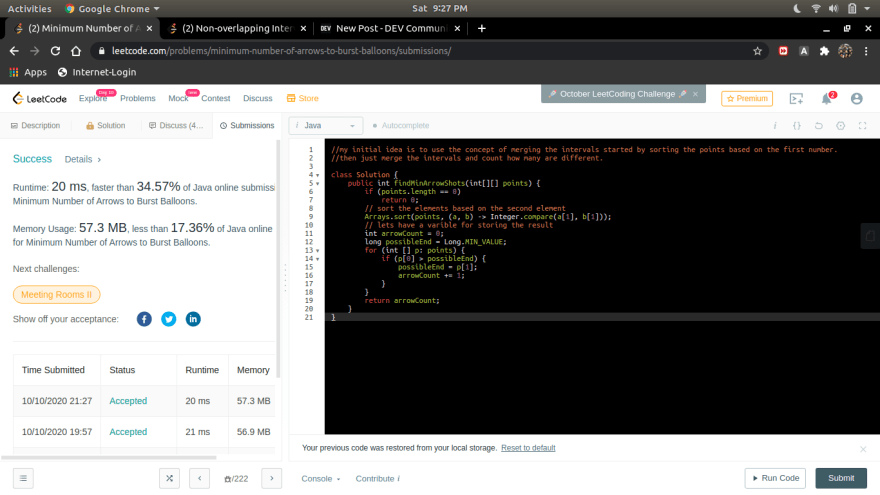Problem Statement
There are some spherical balloons spread in two-dimensional space. For each balloon, provided input is the start and end coordinates of the horizontal diameter. Since it's horizontal, y-coordinates don't matter, and hence the x-coordinates of start and end of the diameter suffice. The start is always smaller than the end.
An arrow can be shot up exactly vertically from different points along the x-axis. A balloon with xstart and xend bursts by an arrow shot at x if xstart ≤ x ≤ xend. There is no limit to the number of arrows that can be shot. An arrow once shot keeps traveling up infinitely.
Given an array points where points[i] = [xstart, xend], return the minimum number of arrows that must be shot to burst all balloons.
Input
Input: points = [[10,16],[2,8],[1,6],[7,12]]
Output: 2
Explanation: One way is to shoot one arrow for example at x = 6 (bursting the balloons [2,8] and [1,6]) and another arrow at x = 11 (bursting the other two balloons).
Example 2:
Input: points = [[1,2],[3,4],[5,6],[7,8]]
Output: 4
Example 3:
Input: points = [[1,2],[2,3],[3,4],[4,5]]
Output: 2
Example 4:
Input: points = [[1,2]]
Output: 1
Example 5:
Input: points = [[2,3],[2,3]]
Output: 1
IDEA
We know the concept of merging two intervals. For merging two intervals, we need to first sort the intervals based on the first number from the number.
for eg: [[x, y]], if we have such an interval we need to sort based on x.
So in this problem we also we need to start with the same concept but a small change, here we need to sort based on the second number, ie say y.
So lets make a common note here:
For merge interval - sort based on first number
For non overlapping interval - sort based on second number
Now we have sorted and we need to find those values that is greater than a particular end.
Here the problem says the arrow goes at a infinite distance from xStart to xEnd.
So we need to find those points where start > end, if we find one then we can update end to the 2nd element of that particular element and increment the count.
Finally returning the count given the minimum number of arrows to burst the balloons.
Time Complexity: Here we are doing a sort and a one pass, so the complexity will be O(nlogn)
ALGORITHM
- Sort the intervals based on the second values of the given intervals.
- Initialise a count and a possibleEnd. Here possibleEnd can be of type long initialised with the minimum value.
- for
int [] p: points-> Check whether the start, that is, p[0] > possibleEnd. If true then -> Update the end with p[1] and increment the count - Finally return this count to get the number of arrows required.
CODE
//my initial idea is to use the concept of merging the intervals started by sorting the points based on the first number.
//then just merge the intervals and count how many are different.
class Solution {
public int findMinArrowShots(int[][] points) {
if (points.length == 0)
return 0;
// sort the elements based on the second element
Arrays.sort(points, (a, b) -> Integer.compare(a[1], b[1]));
// lets have a varible for storing the result
int arrowCount = 0;
long possibleEnd = Long.MIN_VALUE;
for (int [] p: points) {
if (p[0] > possibleEnd) {
possibleEnd = p[1];
arrowCount += 1;
}
}
return arrowCount;
}
}
Github Link: Link
Small Note
This method can also be applied to find the number of intervals to remove the certain intervals to make them non overlapping.
Follow the same algorithm as discussed with a small change in thep[0] >= endand also in the return statement.
givenIntervalLength - count
CODE
class Solution {
public int eraseOverlapIntervals(int[][] intervals) {
if (intervals.length == 0)
return 0;
Arrays.sort(intervals, (a, b) -> Integer.compare(a[1], b[1]));
int count = 0;
int end = Integer.MIN_VALUE;
for (int [] interval: intervals) {
if (interval[0] >= end) {
end = interval[1];
count += 1;
}
}
return intervals.length - count;
}
}








Top comments (3)
Great Explanation
Yes, I found that solution is very popular and helpful: youtu.be/c_5n_qdDRDo
I found that solution is very popular and helpful: youtu.be/c_5n_qdDRDo